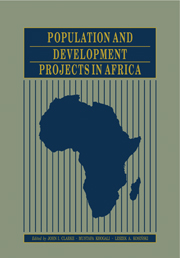Book contents
- Frontmatter
- Contents
- List of Tables
- List of Figures
- List of Contributors
- Preface
- 1 The demographic background to development in Africa
- 2 Development projects and their demographic impact
- 3 Conceptualization of the impacts of rural development projects upon population redistribution
- 4 Capitalism and the population landscape
- 5 Unequal participation of migrant labour in wage employment
- 6 Africa's displaced population: dependency or self-sufficiency?
- 7 Population redistribution and agricultural settlement schemes in Ethiopia, 1958–80
- 8 Populating Uganda's dry lands
- 9 Environmental and agricultural impacts of Tanzania's villagization programme
- 10 Development and population redistribution: measuring recent population redistribution in Tanzania
- 11 Communal villages and the distribution of the rural population in the People's Republic of Mozambique
- 12 A century of development measures and population redistribution along the Upper Zambezi
- 13 Resettlement and under-development in the Black ‘Homelands’ of South Africa
- 14 Development programmes and population redistribution in Nigeria
- 15 Population, disease and rural development programmes in the Upper East Region of Ghana
- 16 Demographic intermediation between development and population redistribution in Sudan
- 17 A typology of mobility transition in developing societies, with application to North and Central Sudan
- 18 Rural population and water supplies in the Sudan
- 19 The impact of the Kenana Project on population redistribution
- 20 Migrant labour in the New Halfa Scheme
- 21 The Gash Delta: labour organization in pastoral economy versus labour requirements in agricultural production
- 22 The impact of development projects on population redistribution to Gedaref Town in Eastern Sudan
- 23 The growth of Juba in Southern Sudan
- Index
17 - A typology of mobility transition in developing societies, with application to North and Central Sudan
Published online by Cambridge University Press: 05 November 2011
- Frontmatter
- Contents
- List of Tables
- List of Figures
- List of Contributors
- Preface
- 1 The demographic background to development in Africa
- 2 Development projects and their demographic impact
- 3 Conceptualization of the impacts of rural development projects upon population redistribution
- 4 Capitalism and the population landscape
- 5 Unequal participation of migrant labour in wage employment
- 6 Africa's displaced population: dependency or self-sufficiency?
- 7 Population redistribution and agricultural settlement schemes in Ethiopia, 1958–80
- 8 Populating Uganda's dry lands
- 9 Environmental and agricultural impacts of Tanzania's villagization programme
- 10 Development and population redistribution: measuring recent population redistribution in Tanzania
- 11 Communal villages and the distribution of the rural population in the People's Republic of Mozambique
- 12 A century of development measures and population redistribution along the Upper Zambezi
- 13 Resettlement and under-development in the Black ‘Homelands’ of South Africa
- 14 Development programmes and population redistribution in Nigeria
- 15 Population, disease and rural development programmes in the Upper East Region of Ghana
- 16 Demographic intermediation between development and population redistribution in Sudan
- 17 A typology of mobility transition in developing societies, with application to North and Central Sudan
- 18 Rural population and water supplies in the Sudan
- 19 The impact of the Kenana Project on population redistribution
- 20 Migrant labour in the New Halfa Scheme
- 21 The Gash Delta: labour organization in pastoral economy versus labour requirements in agricultural production
- 22 The impact of development projects on population redistribution to Gedaref Town in Eastern Sudan
- 23 The growth of Juba in Southern Sudan
- Index
Summary
An attempt is made here to present a general model of mobility transition in developing societies that are undergoing a steady although imbalanced process of transformation. These societies are characterized by a sharp dualism in economy. They have a broad base of a traditional sector (pastoral nomadism and peasant economy) and a small highly localized modern sector in agriculture and industry.
Mobility transition is viewed here as transition of individuals and groups of people on the socio-economic ladder either spatially, temporally or both. In developing societies such a process ranges from transition within pastoral and peasant societies and between them, and from these sectors of the economy into the most modern sectors in agriculture and industry. Consequently we encounter two types of transition: a conservative one represented by transition within nomadism and the peasant economy, and an innovative one represented by mobility from this traditional sector into the modern sector.
Alternatively, mobility transition may be viewed as a process of transition from the local system represented by both nomadism and the peasant economy, into the regional system. Both constitute the complex national mobility transition (Symanski, Manners and Bromley, 1975).
The mobility transition so defined will be tested in North and Central Sudan as a step towards ascertaining its validity for similar areas.
Presentation of the general mobility transition model
Mobility transition in its three interrelated forms and types of local, regional and national systems is a function of a number of integrated variables with special characteristics in developing societies which distinguish them from developed societies.
Information
- Type
- Chapter
- Information
- Population and Development Projects in Africa , pp. 236 - 253Publisher: Cambridge University PressPrint publication year: 1985
Accessibility standard: Unknown
- 1
- Cited by
